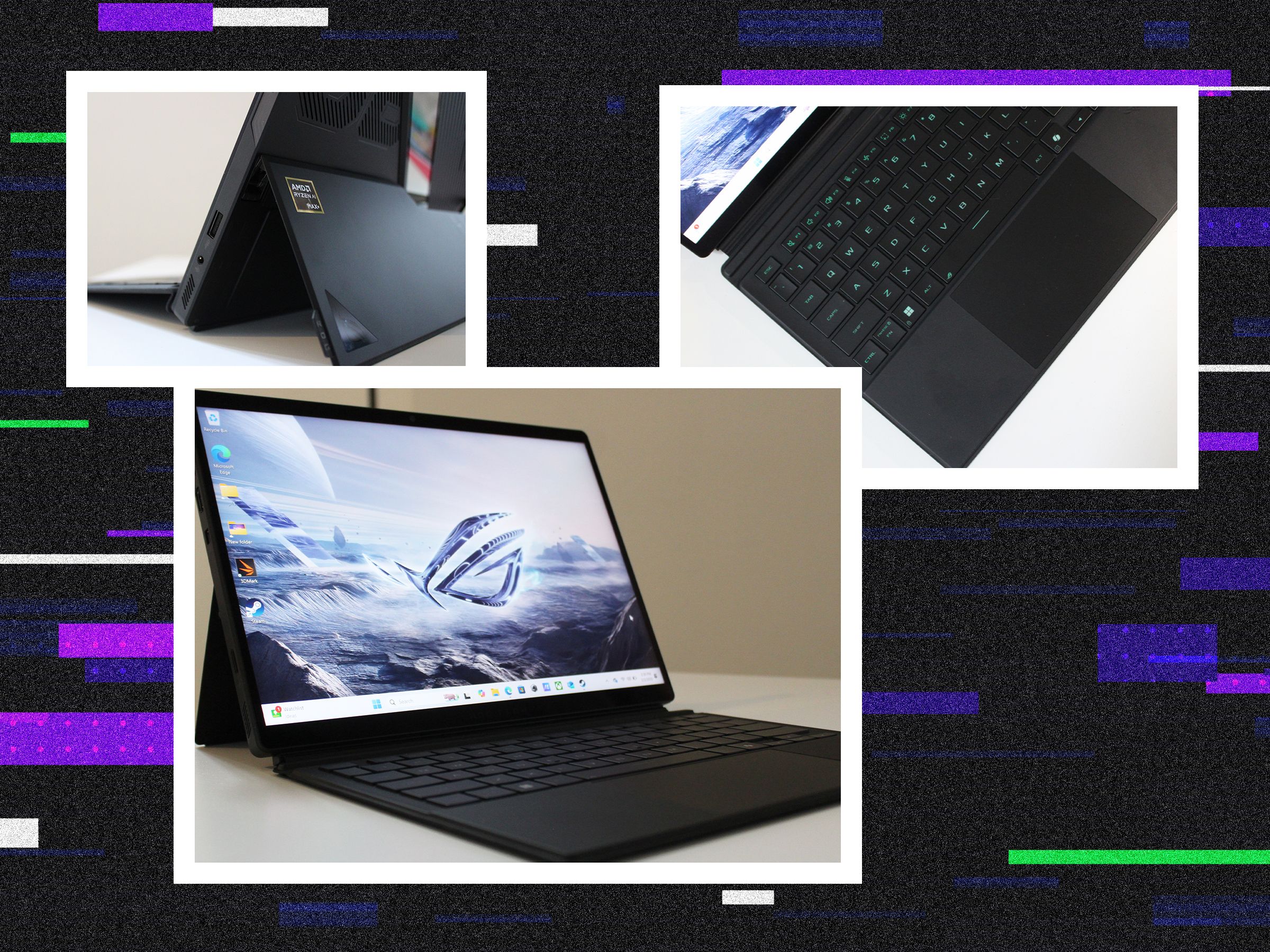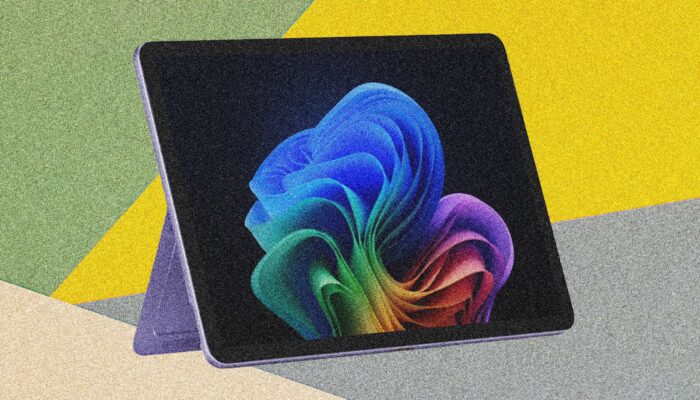“For those who dare.” That’s the Asus tagline for its gaming brand, ROG (an acronym for Republic of Gamers). That’s not something I would typically call out in a review, but the Asus ROG Flow Z13 might be one of those rare gadgets that lives up to its motto.
This machine is a 2-in-1 gaming laptop. It’s like a superpowered Surface Pro that can actually play games. The 2025 iteration gets an experimental new AMD chip to match its already risky design. It’s not a laptop for everyone, but in terms of accomplishing something new in the world of gaming laptops, it’s downright magical.
Photograph: Luke Larsen
One of a Kind
The 2025 ROG Flow Z13 keeps the same basic premise as its 2022 predecessor, with a few noteworthy changes. It’s marginally thicker at 0.59 inch at its thickest, and heavier at 2.65 pounds. That’s with the detachable keyboard included.
This is still a tablet, meaning all the PC components are behind the screen. But it’s not designed to be handled on its own, like most 2-in-1 laptops. The thickness makes it a far cry from an iPad, but so is the performance. It’s a true gaming laptop replacement that just so happens to function as a freestanding tablet when needed.
Photograph: Luke Larsen
The rear design has been streamlined for the better. The unashamed geekiness of the original has been toned down for a simpler look. Asus has kept the distinctive window that still lights up with RGB, naturally. The kickstand that flips out is sturdy but can only be easily accessed from the tab on the right side, unchanged from the previous design.
The detachable keyboard is connected wirelessly along the bottom of the tablet. Like a Surface Pro, the keyboard can magnetize to the bottom of the screen for an inclined typing angle, which is better for lap use. It can rest flat on the table as well, which was my preference. The connection is every bit as sturdy at any angle.
The full-size keyboard is fantastic. There’s no compromise here in layout or key travel. Typing and gaming both feel excellent, and heck, there’s even single-zone RGB backlighting thrown in for good measure. The trackpad is large and smooth, and while the click is a bit stiff and loud for my taste, it’s responsive.
Photograph: Luke Larsen
Because it’s a tablet, the ports are all located awkwardly next to the power and volume buttons along the sides of the screen. Asus includes all the important ports, such as two USB-C, USB-A, HDMI, and a headphone jack. There’s even a microSD card slot for expandable storage.
You can charge using the USB-C port, but you’ll be warned that to get the full performance of the device (and faster charging) you’ll need to use the included and annoyingly hefty 200-watt power adapter, which connects via a proprietary port.
The Most Interesting Chip of the Year
Performance is the most interesting thing about this device. This year, the ROG Flow Z13 uses a special AMD chip we haven’t seen in another mobile device yet: the 16-core Ryzen AI MAX+ 395. It’s an odd chip in just about every way. This massive piece of silicon runs at 55 watts and has otherwise only been showing up in mini PCs like the upcoming Framework Desktop.
When you look at this chip’s raw single-core and multicore performance, it doesn’t hold up against the latest AMD Ryzen chips, the Intel Lunar Lake, or the Apple M3 or M4. But gaming is where things get interesting. The integrated Radeon 8060S Graphics is onboard, differing from every other gaming laptop that uses discrete graphics. The system uses shared memory between the CPU and GPU, with 40 GPU cores to throw at games.
Photograph: Luke Larsen
In Cyberpunk 2077, you can play the game at native resolution (2560 x 1600) and get around 45 frames per second. That’s at the Ultra graphics preset, though, using AMD’s FidelityFX Super Resolution without ray tracing. (FSR is akin to Nvidia’s DLSS, which upscales the image quality in games.) What you’ll want to do is scale down to 1920 x 1200 and enjoy the smooth 70 fps. That’s impressive in a title like Cyberpunk 2077, but digging into the settings a bit, I was able to unlock more performance.
Switching to the system’s Turbo mode provides a significant uptick in gaming performance, as does adjusting the dedicated GPU memory from the default 4 GB to 16 GB in the AMD app. The good news is that even the Turbo mode isn’t as loud as many gaming laptops, and leaving the dedicated GPU memory at 16 GB isn’t problematic in most other apps.
These changes produce 10 percent better frame rates in 3DMark Time Spy, and even more in actual games. If you turn on Frame Generation (which you should), you can play Cyberpunk 2077 at around 100 fps in native resolution at the Ultra setting. If lighter games like Marvel Rivals or Fortnite are more your speed, you’ll be delighted by the snappy performance, enjoying native resolution play at super crisp speeds, while making use of the screen’s 180-Hz refresh rate.
Photograph: Luke Larsen
At its maximum performance levels, the ROG Flow Z13 outdoes the Nvidia RTX 4060 graphics card in some cases. But yes, you can pick up a ROG Zephyrus G14 with an RTX 4070, 32 GB of memory, and 1 TB of storage for less money, and there’s still a performance delta between these two devices.
But in my book, that doesn’t steal anything from what AMD has pulled off. The Radeon 8060S feels like the future of mobile graphics in many ways, allowing for more compact designs that handle heat better and last longer on a charge. The ROG Flow Z13 is the perfect device for such a chip.
That pays off in battery life, too. This year’s model gets a couple more hours from the larger, 70-watt-hour battery. My testing resulted in around 8.5 hours of local video playback, which isn’t great for a modern laptop but is better than most gaming laptops. It’s enough to let the Flow Z13 function as a work device when you’re on the go, but bring the charger just in case.
The Benefits of a Gaming 2-in-1
Those basics are all important, but they don’t address the root question most people will have when they see the ROG Flow Z13 for the first time. What’s the point? Why not just buy a gaming laptop? It’s a fair question. But there are a few key reasons that make this type of design a compelling option.
The first is size. I already mentioned that the ROG Flow Z13 isn’t as thin as other tablets—or even as some laptops like a MacBook Air. But compared to a proper gaming laptop, it’s unimaginably thin and light. Tossing this in your bag will feel like nothing compared to other “thin-and-light” gaming laptops like the Razer Blade 14 or an ROG Zephyrus G14. Even the new trimmed-down Razer Blade 16 doesn’t come close.
Photograph: Luke Larsen
It feels even thinner when you’re using the device itself. When all you have under your palms is that thin keyboard cover, and you’re not seeing how thick the back of the device is, it’s kind of magical, especially while gaming.
That brings me to another huge advantage of this type of design—the thermals. This thing never got above 70 degrees Celsius internally, even under stress testing in Performance mode. And it stayed fairly quiet. It’s especially noticeable when you aren’t gaming. The Flow Z13 does a great job of keeping quiet and cool when it should, which can’t be said for many gaming laptops. That makes it an even better hybrid work/gaming device.
The excellent thermals have the vertical orientation to thank, sucking in tons of air through the intake vents on the back of the tablet, unobstructed by a desk like the bottom of laptops. The exhaust vents, meanwhile, are located right across the top of the tablet, as far away from the keyboard and your hands as physically possible. That’s another big change over gaming laptops, which often spew hot air at your mouse hand.
A Tough Sell?
Photograph: Luke Larsen
I don’t love the limited configurations for the Flow Z13. Asus sells only expensive configurations with at least 32 GB of RAM and 1 TB of storage, starting at over $2,000. It’s a shame there isn’t a lower-tier option to get that starting price down. Not everyone needs that much memory and storage. If the starting price were closer to $1,500, I could see it attracting a larger audience. That’s especially true since the Flow Z13 isn’t necessarily a performance-first machine.
I also wish the speakers and webcam were a bit more impressive. They get the job done and are better than what you find on many gaming laptops, but if they could match the Surface Pro, they’d have an even stronger upper hand over even the most premium gaming laptops. And I’d be remiss without mentioning the newly launched Nvidia RTX 50-series Laptop GPUs. It’ll be a bit before the lower-tier RTX 5050 and 5060 laptops arrive, but when they do, they may make the comparison to the Flow Z13 less favorable.
The price-to-performance comparison with comparable gaming laptops doesn’t play out in the Flow Z13’s favor. It will never hold a candle to its peers on that spec alone. But that’s never been the point. Instead, the Flow Z13 continues to challenge the conventional idea of gaming laptops, and with the 2025 model, it’s surprisingly successful.




